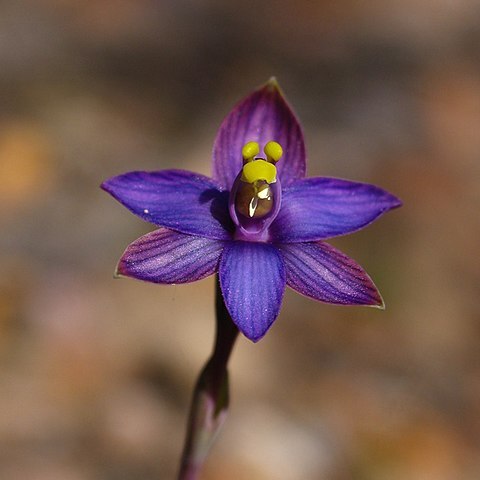Leaf spirally twisted, dark green, 30–70 × 3–7 mm; basal part of leaf widest, purplish, its margins often lobed and undulate, short hairs on veins and margins; leaf narrowing abruptly above base then linear, spirally twisted, encircling flower stem. Flower stem 90–150 × 1 mm, wiry, usually 1-flowered, rarely 2. Sterile bract 1. Flowers upward-facing, 15–27 mm across, internally dark purple to violet with darker longitudinal veins, sepals more reddish than other segments, shiny, externally paler and heavily veined. Sepals and petals 8–10 × 4–7 mm, sepals sometimes greenish or reddish, dorsal sepal widest, labellum narrowest. Column 4–5.5 × 2.5–4 mm, broadly winged, purple; post-anther lobe vestigial, top with dense cluster of grape-like, globose papillae; column arms obliquely erect or bent forwards, ear-like, yellow, sometimes twisted, smooth or warty. Anther at top of column, projecting forward, yellow, apex beak-like, 0.5–0.8 mm long.
More
Plant at fl. c. 10–15 cm. tall. Lf flexuous or spirally twisted round stem; sheath broad, finely and closely puberulous, as is stem immediately below; lamina 3–6 cm. long, linear and very much narrower than sheath. Infl. 1–2-fld. Per. c. 8–14 mm. long, dark purplish blue with darker veins. Sepals, petals and labellum alike, lanceolate or oblong-lanceolate, acute or shortly acuminate. Column short; anther largely exposed; connective prolonged; column-arms ± oblong, thick and fleshy, neither lobed nor ciliate, bright yellow; post-anther lobe lacking; small calli sts present across back of anther between bases of column-arms.
Widespread, but rare; found growing on slopes and ridges in light open forest, heath and heathy woodland in freely draining sand and clay loam.

